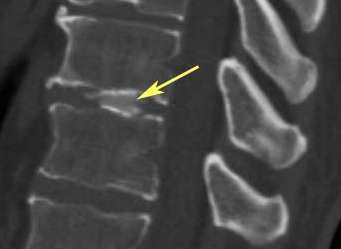

MedFriendly®


Calcified Disc
To understand what a calcified disc is, it is first
necessary to understand a few terms. To begin
with, vertebrae are bones that form an opening in
which the spinal cord passes. These bones are
stacked one on top of another. Each individual
bone that makes up the vertebrae is called a
vertebra. In between the vertebrae are flat,
cushiony discs (known as intervertebral discs).
When people get older, calcium deposits can form
in the discs, making them less cushiony and thus,
less able to absorb shocks. Calcium is a natural
element that is very important for bone formation.
A calcified disc shown by the arrow.
FEATURED BOOK: Healing Back Pain: The Mind-Body Connection
Calcium deposits can result from chronic inflammation of the vertebrae, a condition
known as spondylitis. Inflammatory cells produce chemicals that damage the bone. This
causes the bone to dissolve and weaken around the edge of each joint. The bone
continuously tries to repair itself by producing new tissue but as this process continues
the bones continue to weaken. Eventually, the inflammation stops and the body
produces calcium to heal the damaged bone. For uncertain reasons, the calcium
spreads to the disks between the vertebrae. This causes the vertebrae to fuse together
(because the cushiony discs between them have hardened), a condition sometimes
called bony ankylosis. There is no cure for this condition. It is treated with pain
medication, physical therapy, and exercise. Calcified disc comes from the Latin word
“calx” meaning “lime” and the Greek word "diskos" meaning "flat plate." Put the two words
together and you have "lime flat plate."
"Where Medical Information is Easy to Understand"™















